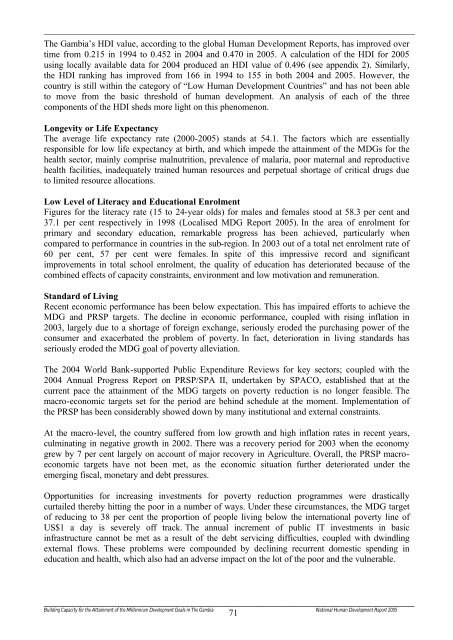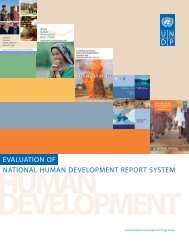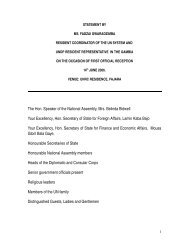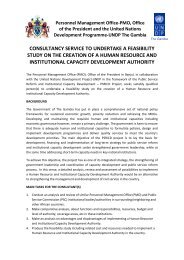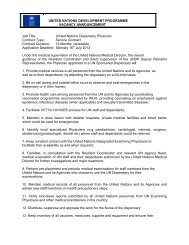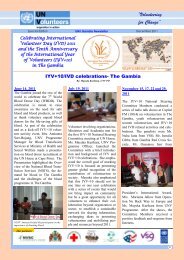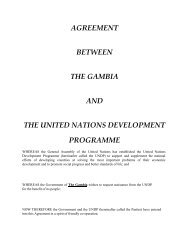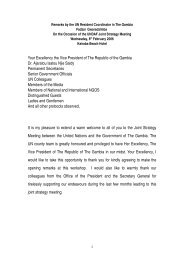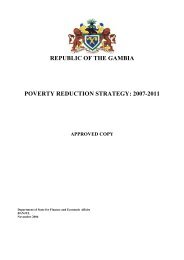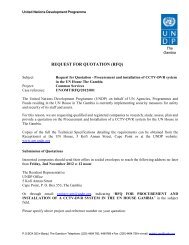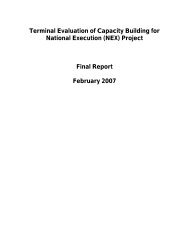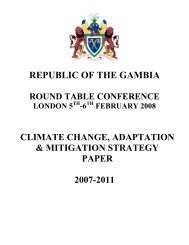Introduction - UNDP The Gambia
Introduction - UNDP The Gambia
Introduction - UNDP The Gambia
You also want an ePaper? Increase the reach of your titles
YUMPU automatically turns print PDFs into web optimized ePapers that Google loves.
________________________________________________________________________________________________________________________<br />
<strong>The</strong> <strong>Gambia</strong>’s HDI value, according to the global Human Development Reports, has improved over<br />
time from 0.215 in 1994 to 0.452 in 2004 and 0.470 in 2005. A calculation of the HDI for 2005<br />
using locally available data for 2004 produced an HDI value of 0.496 (see appendix 2). Similarly,<br />
the HDI ranking has improved from 166 in 1994 to 155 in both 2004 and 2005. However, the<br />
country is still within the category of “Low Human Development Countries” and has not been able<br />
to move from the basic threshold of human development. An analysis of each of the three<br />
components of the HDI sheds more light on this phenomenon.<br />
Longevity or Life Expectancy<br />
<strong>The</strong> average life expectancy rate (2000-2005) stands at 54.1. <strong>The</strong> factors which are essentially<br />
responsible for low life expectancy at birth, and which impede the attainment of the MDGs for the<br />
health sector, mainly comprise malnutrition, prevalence of malaria, poor maternal and reproductive<br />
health facilities, inadequately trained human resources and perpetual shortage of critical drugs due<br />
to limited resource allocations.<br />
Low Level of Literacy and Educational Enrolment<br />
Figures for the literacy rate (15 to 24-year olds) for males and females stood at 58.3 per cent and<br />
37.1 per cent respectively in 1998 (Localised MDG Report 2005). In the area of enrolment for<br />
primary and secondary education, remarkable progress has been achieved, particularly when<br />
compared to performance in countries in the sub-region. In 2003 out of a total net enrolment rate of<br />
60 per cent, 57 per cent were females. In spite of this impressive record and significant<br />
improvements in total school enrolment, the quality of education has deteriorated because of the<br />
combined effects of capacity constraints, environment and low motivation and remuneration.<br />
Standard of Living<br />
Recent economic performance has been below expectation. This has impaired efforts to achieve the<br />
MDG and PRSP targets. <strong>The</strong> decline in economic performance, coupled with rising inflation in<br />
2003, largely due to a shortage of foreign exchange, seriously eroded the purchasing power of the<br />
consumer and exacerbated the problem of poverty. In fact, deterioration in living standards has<br />
seriously eroded the MDG goal of poverty alleviation.<br />
<strong>The</strong> 2004 World Bank-supported Public Expenditure Reviews for key sectors; coupled with the<br />
2004 Annual Progress Report on PRSP/SPA II, undertaken by SPACO, established that at the<br />
current pace the attainment of the MDG targets on poverty reduction is no longer feasible. <strong>The</strong><br />
macro-economic targets set for the period are behind schedule at the moment. Implementation of<br />
the PRSP has been considerably showed down by many institutional and external constraints.<br />
At the macro-level, the country suffered from low growth and high inflation rates in recent years,<br />
culminating in negative growth in 2002. <strong>The</strong>re was a recovery period for 2003 when the economy<br />
grew by 7 per cent largely on account of major recovery in Agriculture. Overall, the PRSP macroeconomic<br />
targets have not been met, as the economic situation further deteriorated under the<br />
emerging fiscal, monetary and debt pressures.<br />
Opportunities for increasing investments for poverty reduction programmes were drastically<br />
curtailed thereby hitting the poor in a number of ways. Under these circumstances, the MDG target<br />
of reducing to 38 per cent the proportion of people living below the international poverty line of<br />
US$1 a day is severely off track. <strong>The</strong> annual increment of public IT investments in basic<br />
infrastructure cannot be met as a result of the debt servicing difficulties, coupled with dwindling<br />
external flows. <strong>The</strong>se problems were compounded by declining recurrent domestic spending in<br />
education and health, which also had an adverse impact on the lot of the poor and the vulnerable.<br />
________________________________________________________________________________________________<br />
Building Capacity for the Attainment of the Millennium Development Goals in <strong>The</strong> <strong>Gambia</strong> National Human Development Report 2005<br />
71


